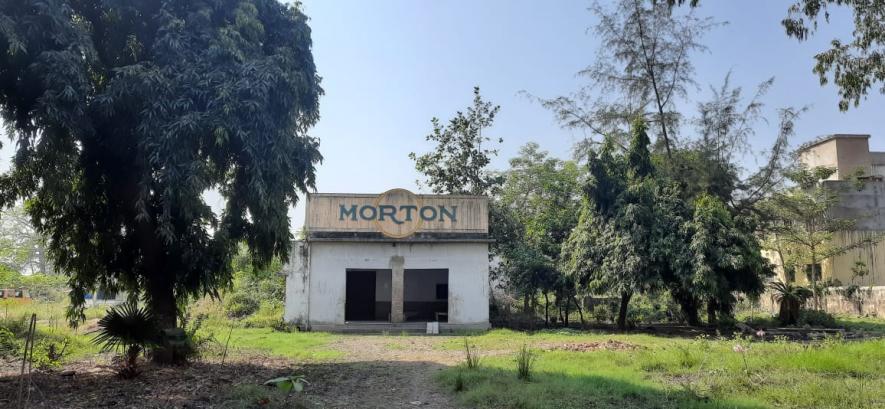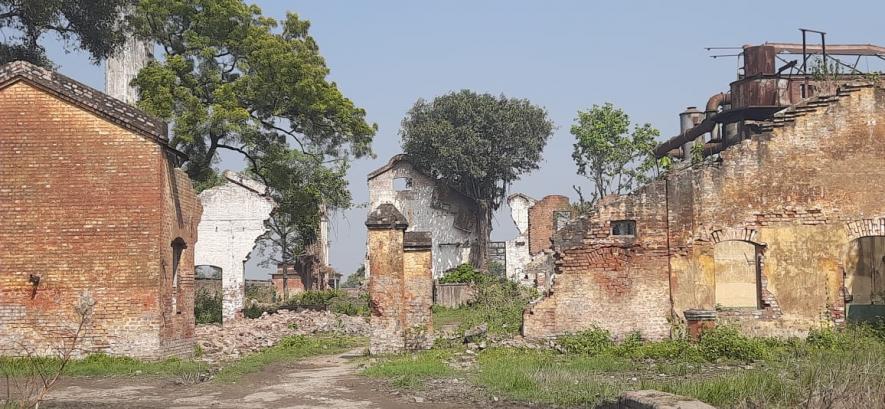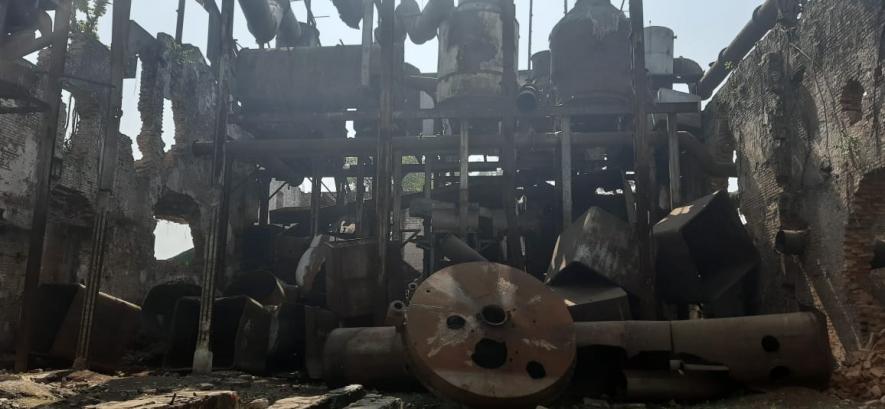Bihar Elections: Once Home to Morton Toffee Makers, Saran’s Marhaura Now a Dying Town

Saran (Bihar): The ‘Morton’ inscription appears in an old building as one takes the straight road about half a kilometre away from Marhaura Bazaar in Saran district, where polling is underway on November 3. Morton was once a household name — most popular among children — in the 1980s and 1990s, reminding of a toffee, which had milk, sugar and fine coconut powder.
Once a vibrant place of factories and a model of self-sufficiency in the state till the early 1990s, Marhaura Industrial Area has of late turned into a graveyard of industries. The industrial estate boasted of four factories of national fame — Cawnpore Sugar Works Limited (Bihar’s first sugar mill, which was set up 1904 and shut down in 1997), Morton Confectionery [C&E Morton (India) Limited, a producer of milk products and confectionery], Saran Distillery and Saran Engineering Works. Established in 1929, C&E Morton used to sell its products under the trade name Morton.
All four of them were closed down one by one over a decade ago. Chief Minister Nitish Kumar-led government’s promise to revitalise Marhaura mills and open new ones is biting dust.
Rail tracks were laid for the entire industrial area, whose remains are still found. However, the residents of the area are allegedly selling scraps of the mills. They are also stealing bricks by breaking the historic building of the mill, which includes a guest house with 52 rooms.

Rajkumar Singh, a young man who is living in the industrial area, said, “If this mill was functional, why would we go out for jobs? My father tells that 80% people of Marhaura used to get employment from it. But now, it has turned into ruins.”
According to the Saran Gazetteer of the year 1951, 2,500 workers used to work here but by the time the mills were closed, their number had come down to about 1,200.
WHY WERE THE FACTORIES CLOSED?
Kamakhya Singh, a guard who is also serving as the caretaker of the building, said, “Exploitative wages were the bone of contention between the management and workers. When the mill closed in 2000, officers were getting Rs 5,000 and workers Rs 2,500. It led to a clash, and the factories were closed. The employees were given voluntary retirement from service (VRS).”
A resident of Marhaura, Dr NK Singh said the sugar factory was run under the Ministry of Textile long ago. Recession in the sugar industry caused its closure.
Also read: Bihar Elections: In Crucial Phase 2, NDA Faces Trial by Fire
“There were three main reasons for the closure of the sugar mill: one, all the mills of the British India Corporation (BIC) were taken over by the textile ministry, which had nothing to do with sugar production; two, the pollution department closed the distillery factory due to technical reasons, which was the source of the sugar mill’s revenue; three, the crushing capacity of the sugar mill was not increased with time,” he explained.
SHATTERED HOPES
Politicians representing this area in Parliament and Assembly have been taking the local residents for a ride, using the issue of reopening these factories to their maximum advantage time and again.
The Board of Institutional Finance and Restructuring (BIFR) passed the assets and liabilities of the sick, government-owned Cawnpore Sugar Works Ltd on to Hari Shankar Tiwari, a former minister in the then Uttar Pradesh government (2003-2007), who purchased it but failed to resume operations.
Later, UP-based JHV Distilleries and Sugars Ltd, owned by one Jawahar Jaiswal, acquired it and started making efforts for its revival. According to Singh, he had claimed that it would start production by November 2007. The company had assured farmers and employees that their payment dues would be cleared in three installments, two years after production begins.
The sugar mill reportedly still owes dues worth Rs 4 crore to the farmers and Rs 4 crore to the state government.
Saran MP Rajiv Pratap Rudy had also assured the sugarcane growers that the factory would reopen soon and had urged them to grow sugarcane. Believing him, the farmers in the region grew sugarcane to burn it later as a result of the heavy loss they suffered because the mill never started operations. Many of them are still under financial deficit, residents told NewsClick.
Residents of the area suspected that politicians were playing with their sentiments and harbouring ulterior motives of selling it at scrap value. They opposed the move.

“A beautiful dream was shattered. Our marriages and celebrations of festivals were dependent on these factories. It was an emotional moment for us when we heard in 2007 that smoke will begin billowing from the sugar mill’s chimney once again. We were unable to express our feelings. But we were wrong. Politicians played with our emotions. We were betrayed,” said Joginder Rai.
Jitendra Rai of the Rashtriya Janata Dal (RJD) is the sitting MLA from Marhaura Assembly constituency. He is trying to score a hattrick victory in this election against Janata Dal (United)’s Altaf Raju.
RJD chief Lalu Prasad, who represented Chhapra, now Saran parliamentary constituency, had also claimed that only he could help restart the sugar factory. But his assurance also proved to be hollow. As railway minister, he took initiative to revive Dalmia Nagar factory in Rohtas and Bharat Wagon and Engineering Corporation Limited (BWEL) in Muzaffarpur but allegedly ignored the Saran engineering factory in his constituency, which once manufactured parts for railway locomotives. However, people are hopeful that the RJD and the Mahagathbandhan will bring some change in their situation.
Also read: Bihar Elections: Winds of Change in Hajipur and Sonepur Bring Ominous Signs for BJP
“Since Tejashwi ji has promised 10 lakh jobs, the sugar mill will reopen if the Mahagathbandhan (RJD-Congress-Left parties alliance) forms the government. Laluji had opened a rail engine factory at Marhaura, but the Central government reduced it into an assembling unit, which has employees from outside Bihar. There is nothing for the local youth,” said Rai.
President of the Marhaura Sugar Mill Mazdoor Union, Ram Babu Singh, said, “The sugar mill still has 650 acres of land. If the government wishes and makes honest and serious efforts, the mill will open once again.”
BUFFALO REARING NOW A HISTORY
A short distance from Morton toffee factory and sugar mill is Deodhi village. Earlier, sugarcane was cultivated in this village, where every farmer also used to rear buffaloes.

Suresh Rai was one among such farmers. “We used to sell sugarcane to the sugar factory and milk to the toffee’s factory. We had a very good income then. But the factories were closed, we stopped buffalo rearing and growing sugarcane, which was replaced with wheat and paddy. I have four sons. As there is no job here, they are now working in Kolkata and Odisha as labourers,” he said.
Around 20,000 farmers were directly affected by the closure of the mill.
Going down the memory lane, farmers recalled their golden days. The receipt they used to get from the sugar mill for their sugarcane was like a bank cheque. On delivering sugarcane to the mill, farmers used to be issued a receipt based on which their due payments used to be made. This piece of paper was very important in the market.
“Even goldsmiths used to come to us, urging to buy jewellery. Showing the receipt in the market, we used to buy anything,” said Kamakhya.
Raghunath Rai said, “Whoever needed money, he used to sell the receipt issued by the sugar mill. Suppose there is a receipt of Rs 10,000, it was sold for Rs 9,000. When the sugar mill was functional, no one ever faced financial problem.”
However, the question that arises is, why does the government not seem to want to revive industries in a state which has been witnessing migration in large numbers for years?
Also read: Bihar Elections: The Tragic Face of De-Industrialisation
Get the latest reports & analysis with people's perspective on Protests, movements & deep analytical videos, discussions of the current affairs in your Telegram app. Subscribe to NewsClick's Telegram channel & get Real-Time updates on stories, as they get published on our website.
























